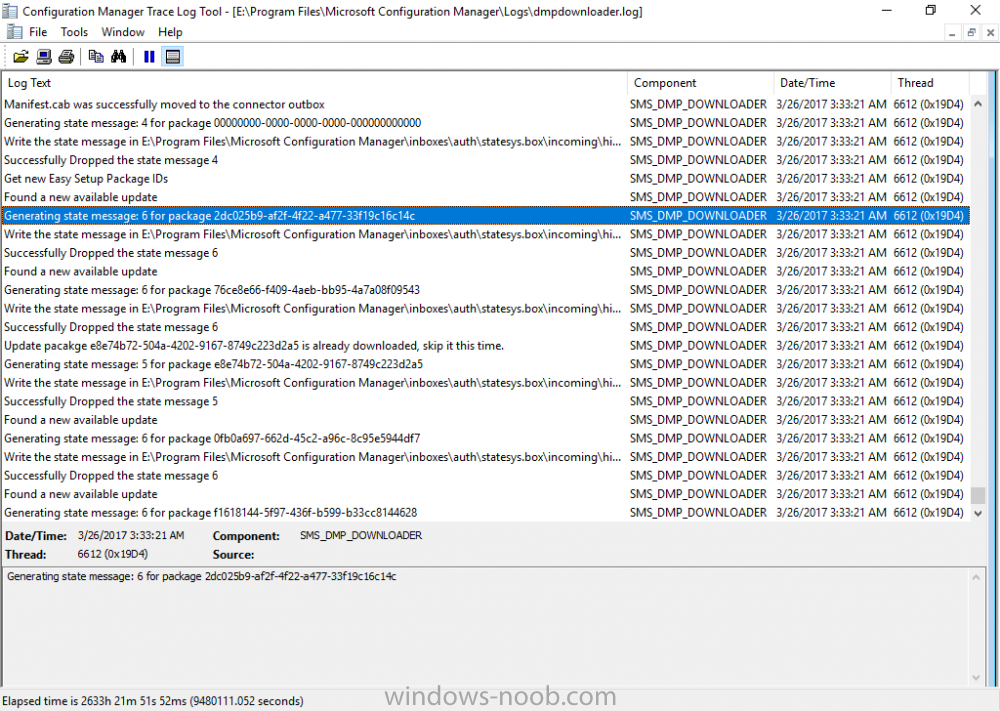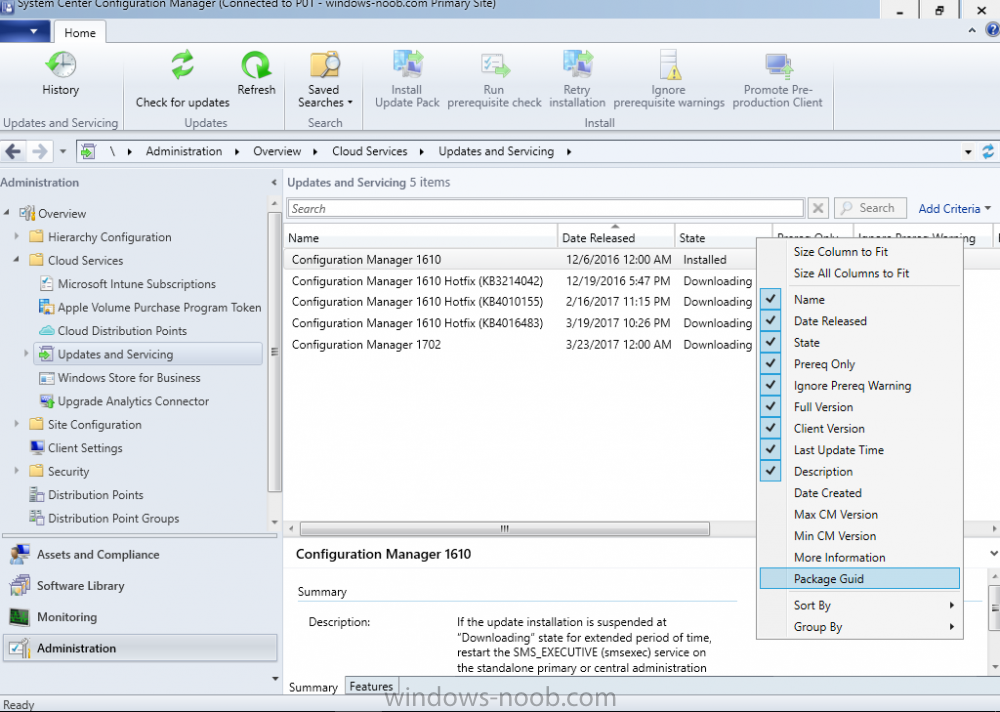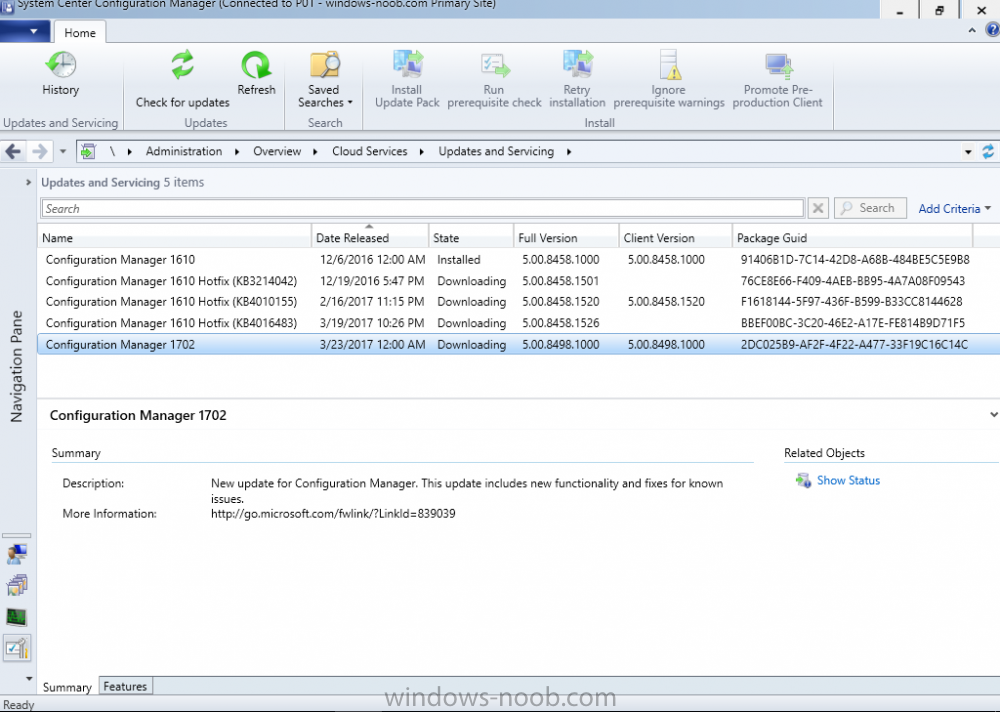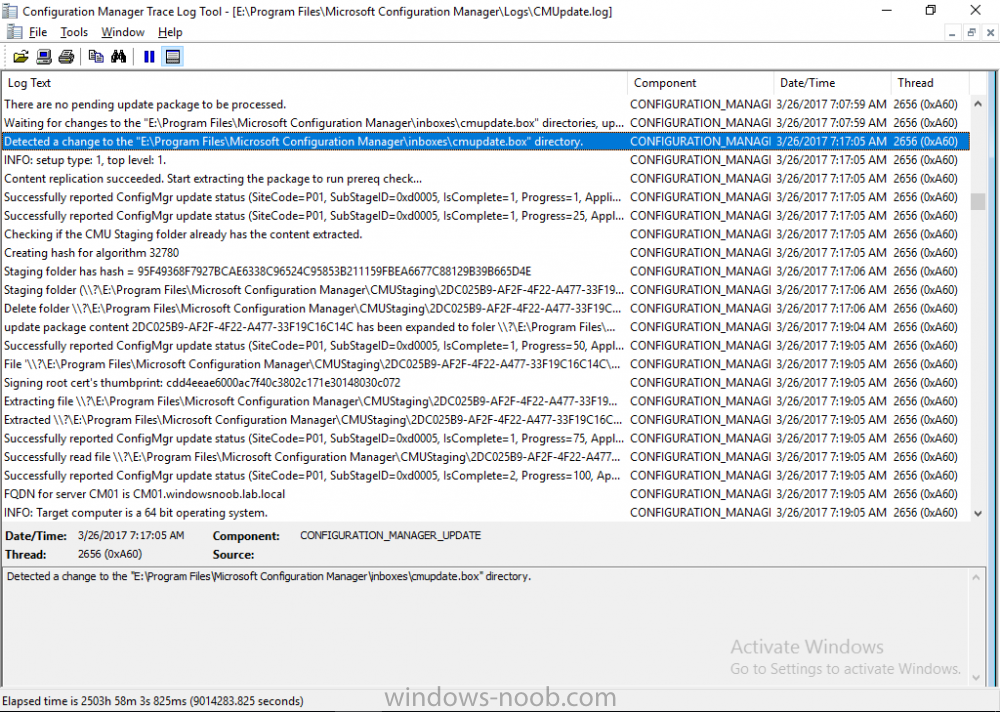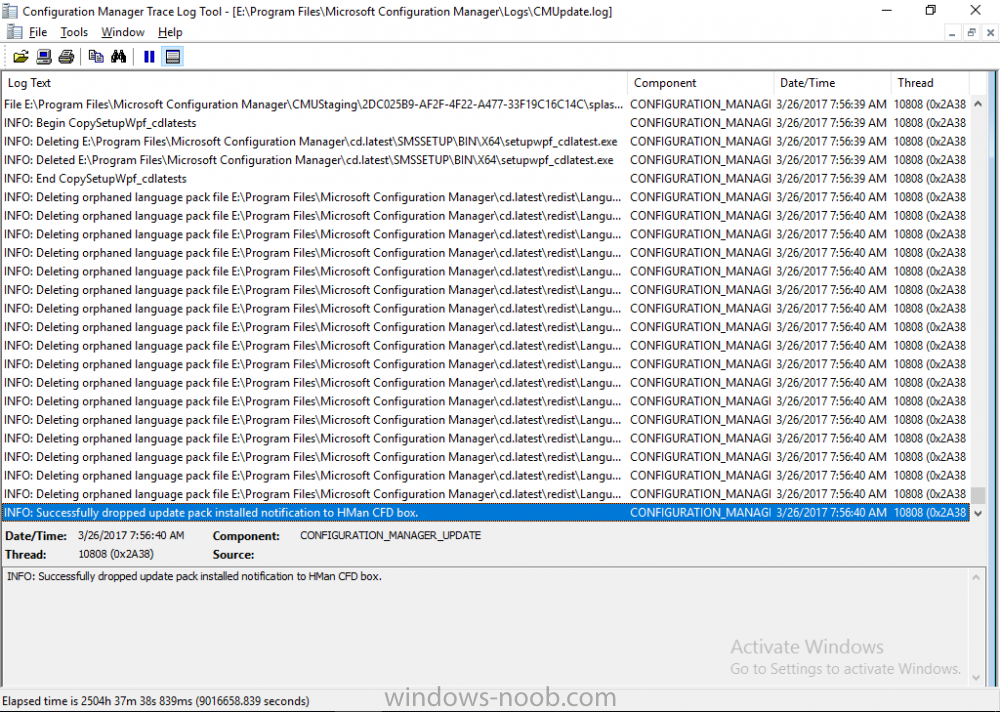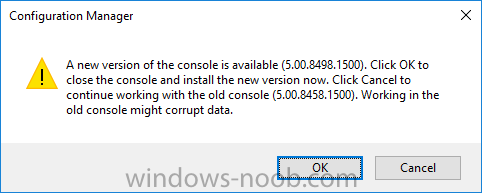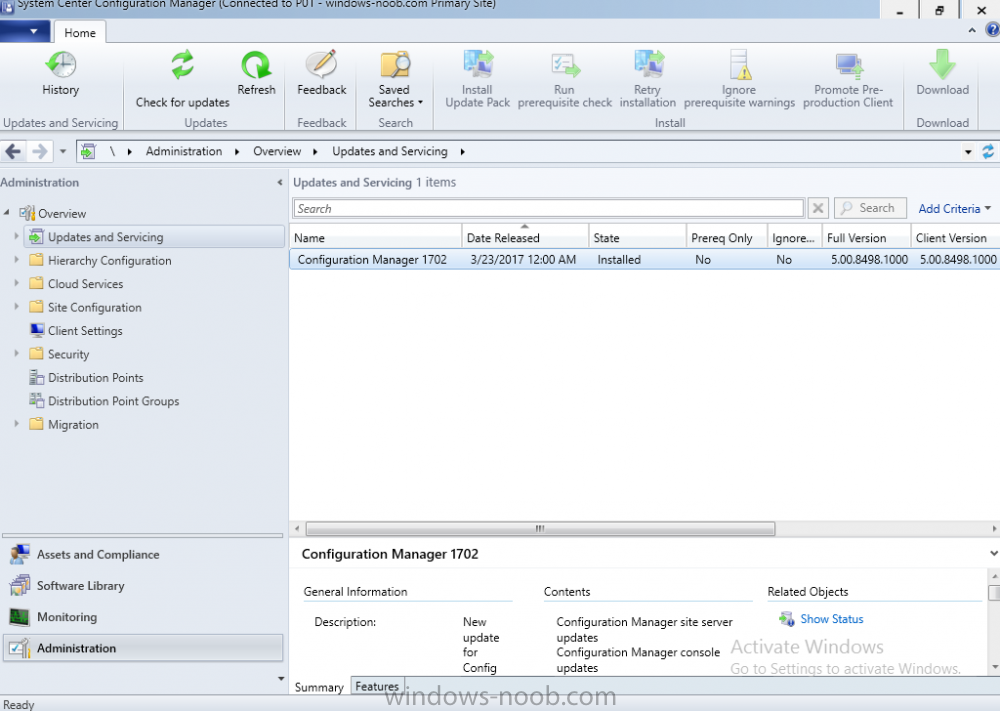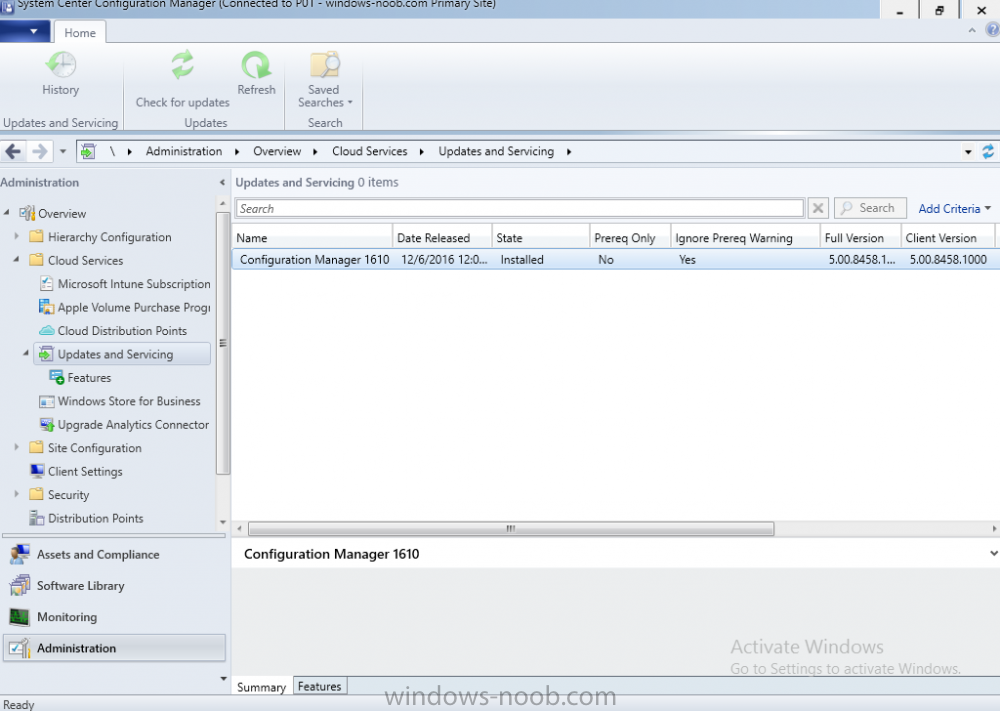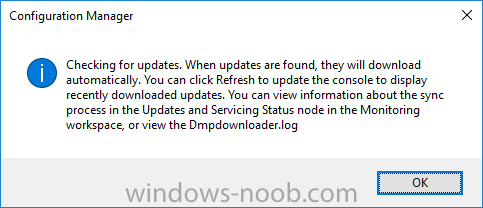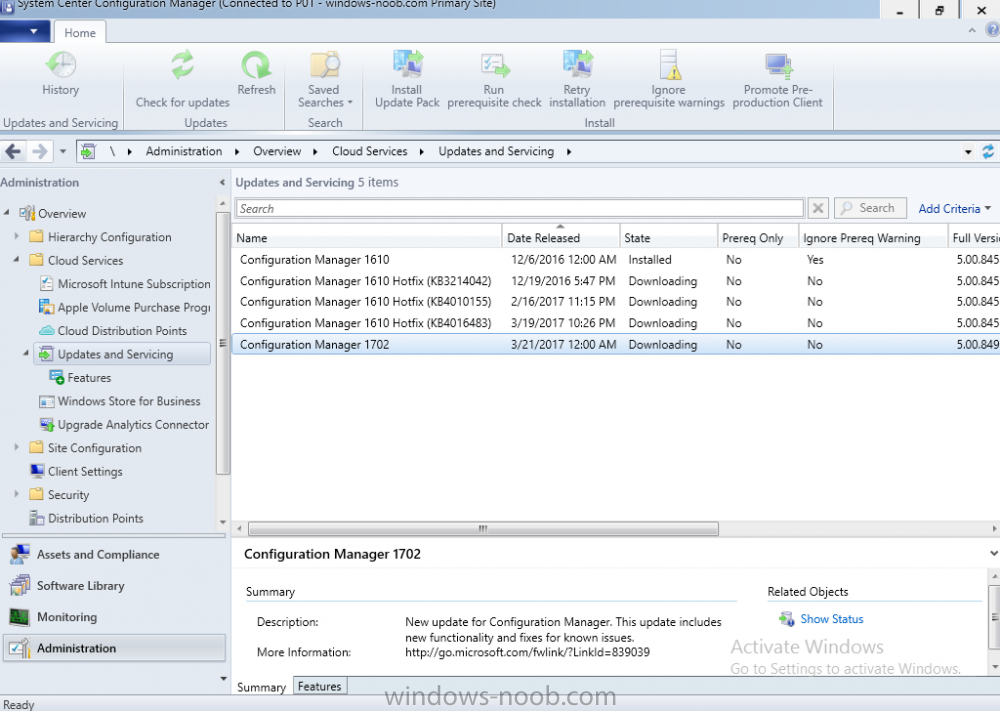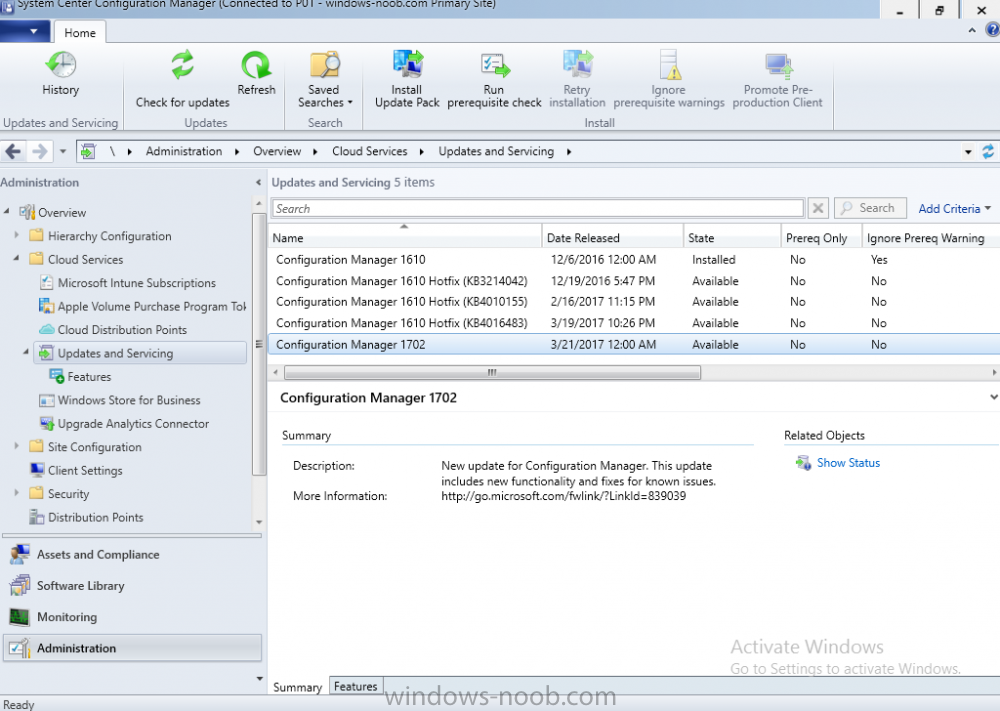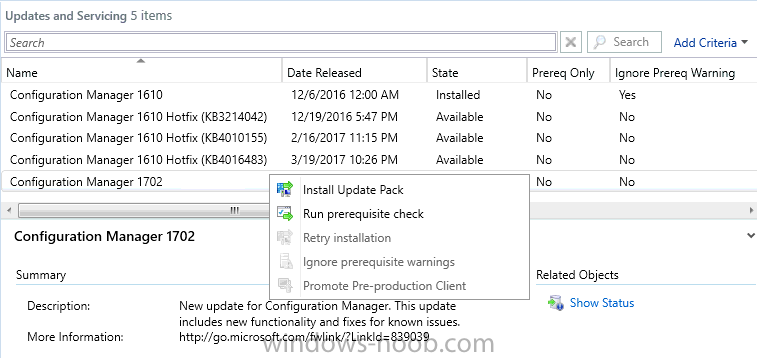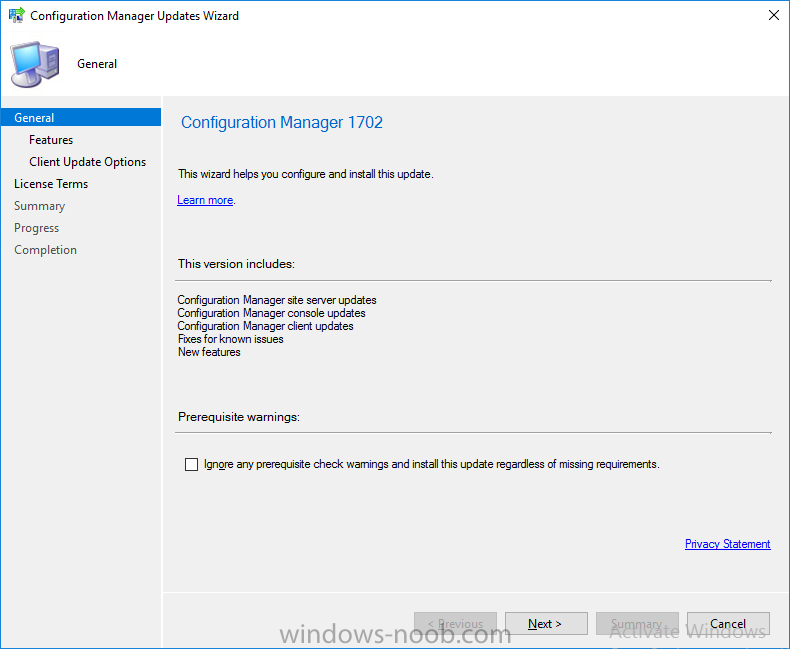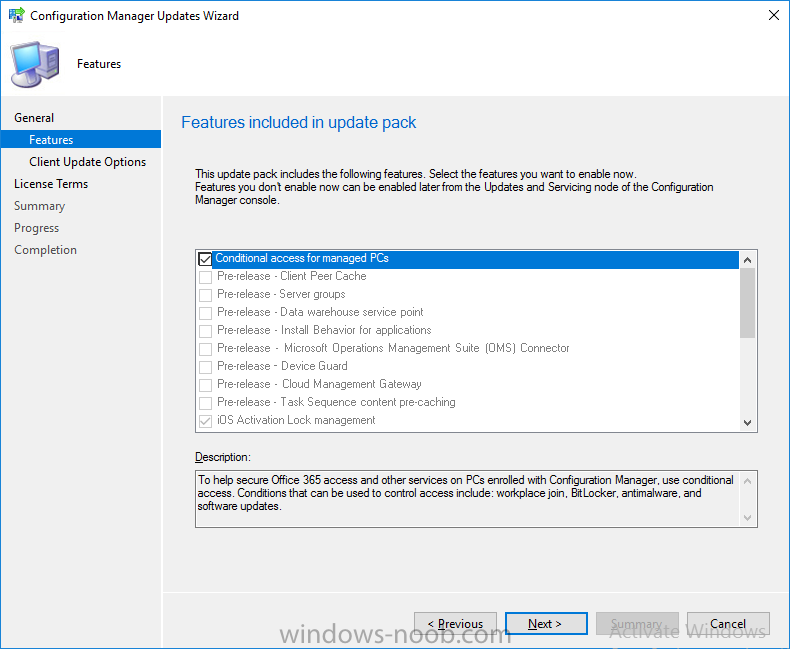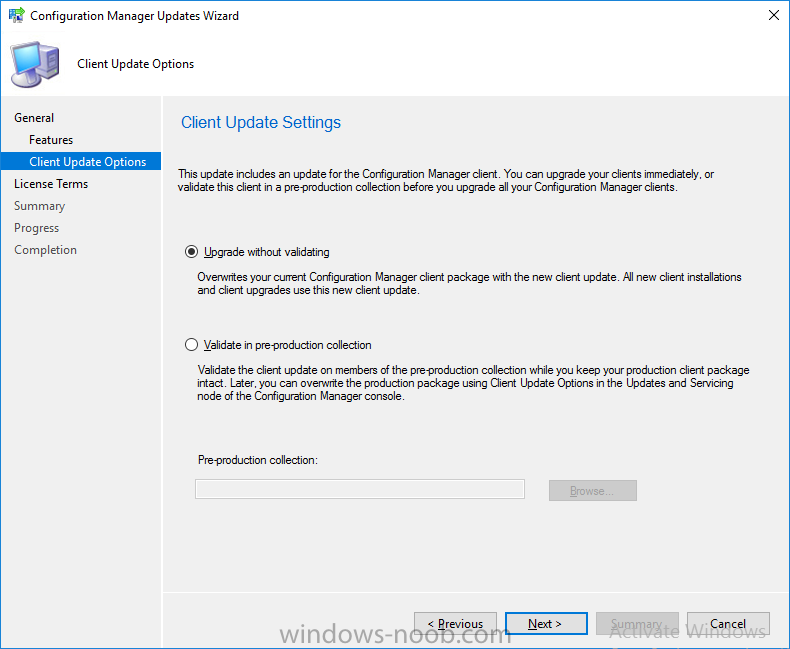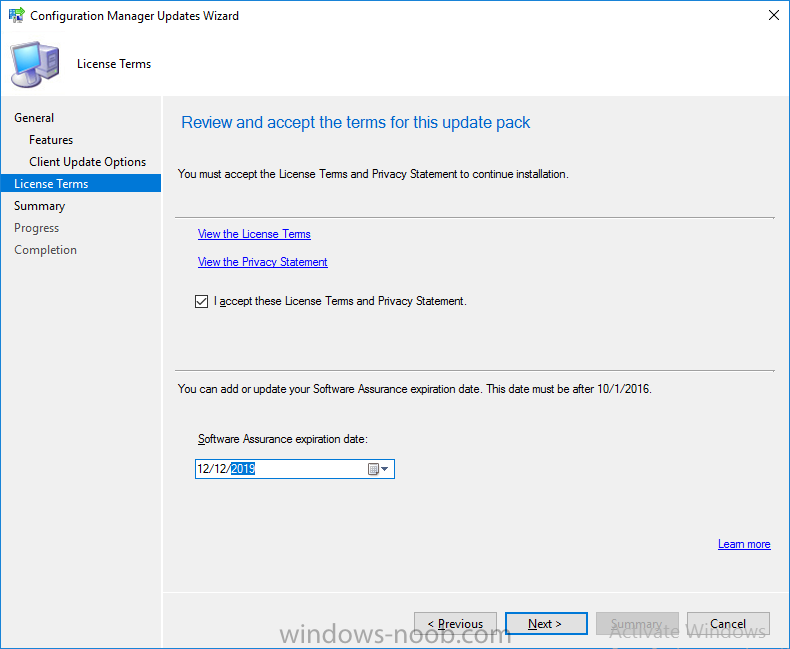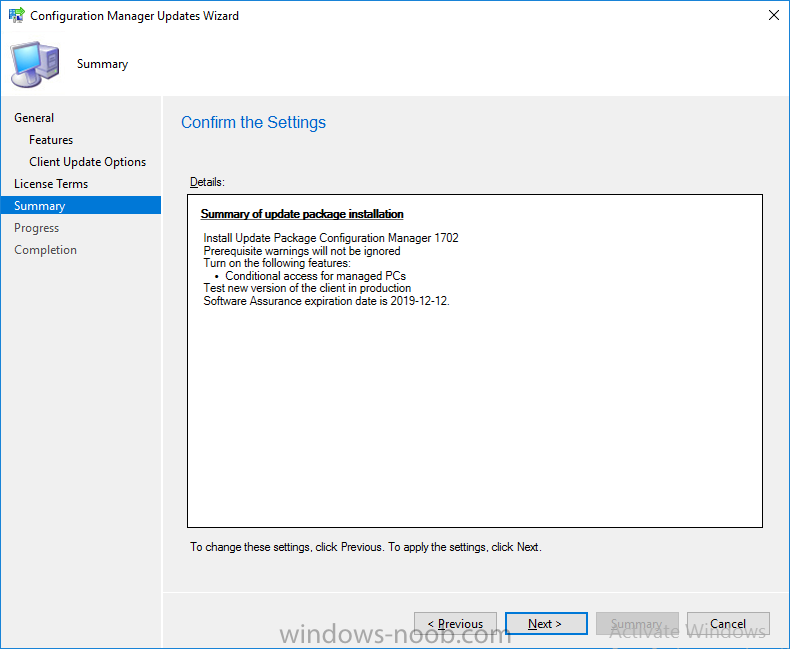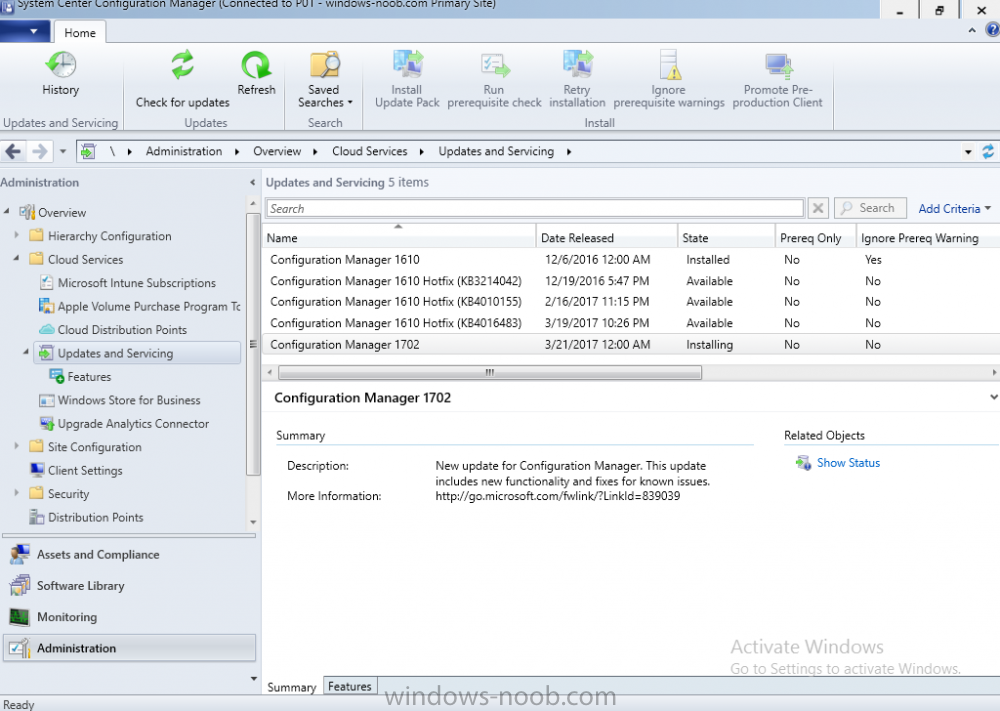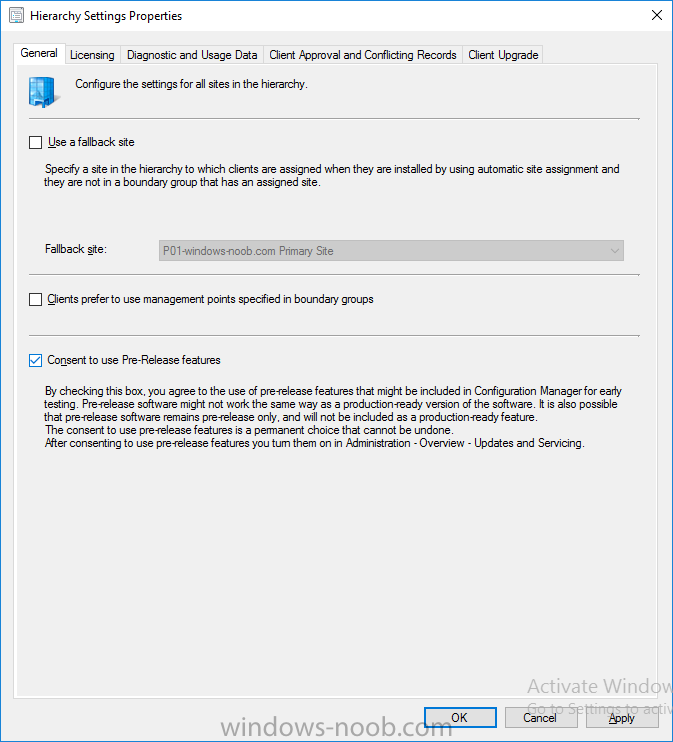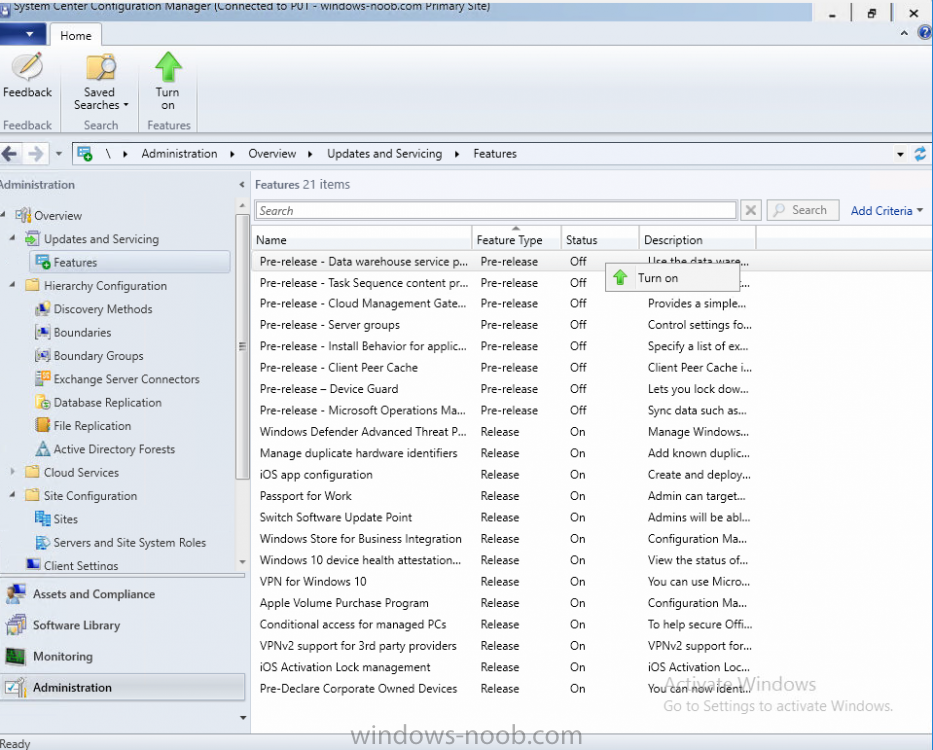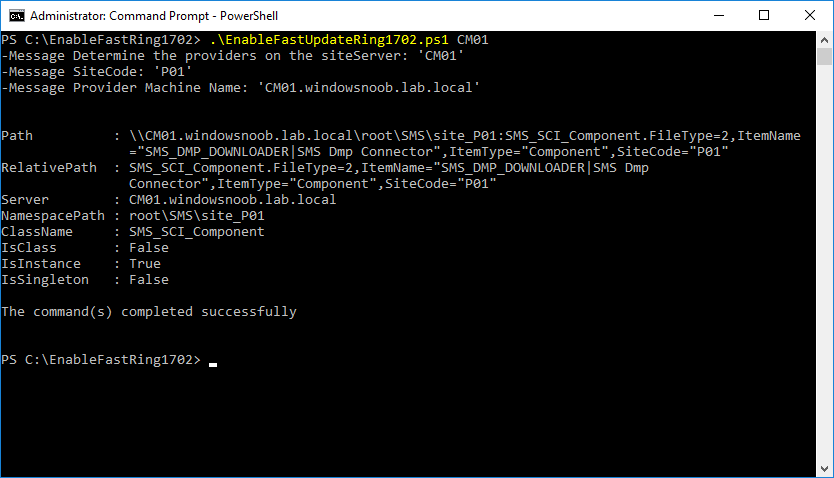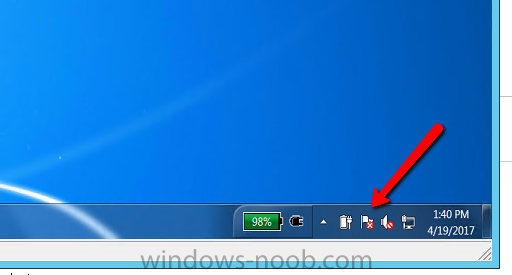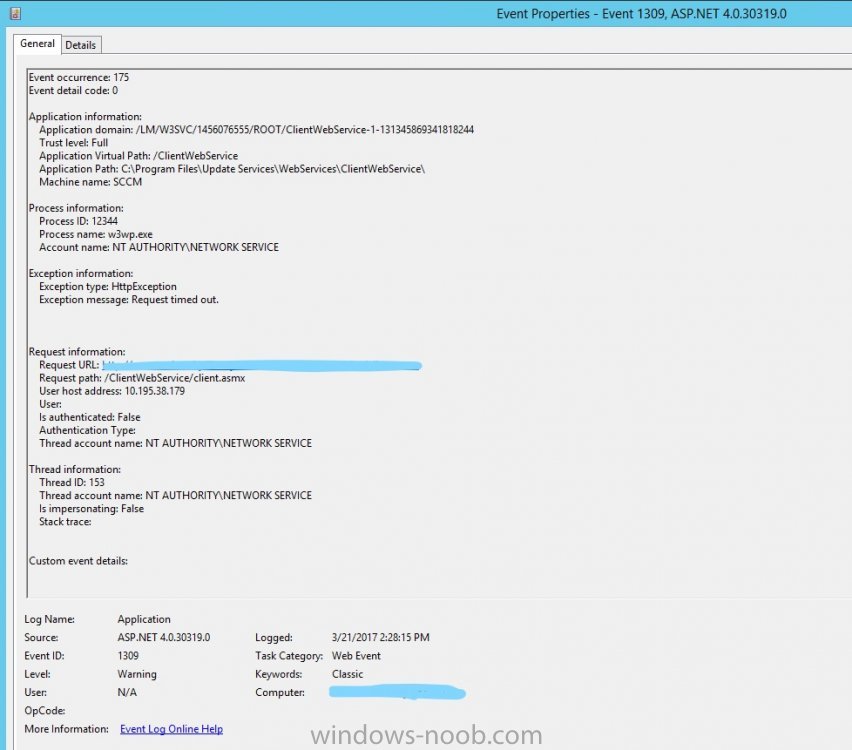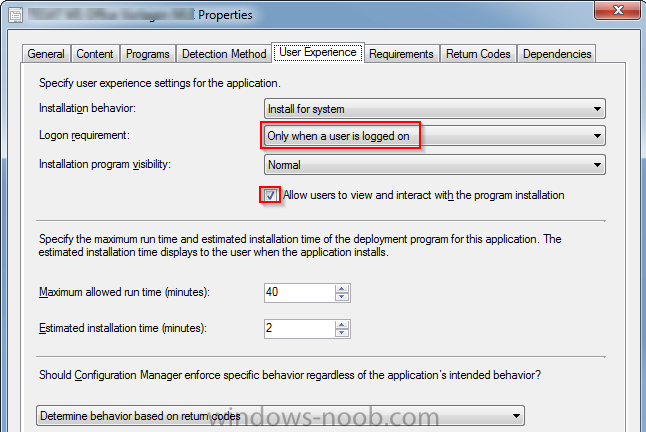Search the Community
Showing results for tags 'sccm'.
-
Hi, I had to update my SCCM environment to 1702 due to the Office 365 update bug. The upgrade went okay until the install procedure copied the new x86 and x64 boot images. Now the installation seems to be stuck for around an hour (nothing happens in cmupdate.log) These are the last messages my SCCM delivered: INFO: Default SMS_BootPackageImage instance for x64 already exists. Updating the instance now. CONFIGURATION_MANAGER_UPDATE 28.04.2017 14:45:55 11116 (0x2B6C) INFO: The source path for the old boot image package is \\blanked out\SMS_PS1\osd\boot\x64\boot.PS100005.wim CONFIGURATION_MANAGER_UPDATE 28.04.2017 14:45:55 11116 (0x2B6C) INFO: Successfully copied the new source WIM file from \blanked out\SMS_PS1\osd\boot\x64\boot.wim to \\blanked out\SMS_PS1\osd\boot\x64\boot.PS100005.wim CONFIGURATION_MANAGER_UPDATE 28.04.2017 14:45:56 11116 (0x2B6C) Should I just roll back to my previously made snapshot or wait further until something happens? There are no errors in the log that I could think of being the reason of this?
- 2 replies
-
- sccm
- 1702 update
-
(and 1 more)
Tagged with:
-
Hoping someone can shed some light on an ongoing issue... When I image a computer, via PXE, it takes about 24 hours before I can see it in SCCM. Our administrator can see the computer withing minutes. At one point I was also able to see the computer within minutes, but now it reverted back to the 24 hour delay. Can anyone assist? Thank you,
-
Introduction In a previous post you used PowerShell scripts to quickly install System Center Configuration Manager (Current Branch) version 1606 and then upgraded it using Updates and Servicing to System Center Configuration Manager (Current Branch) version 1610. In case you are not already aware there are two main branches (of Configuration Manager) available: System Center Configuration Manager (Current Branch) System Center Configuration Manager (Technical Preview) System Center Configuration Manager (Current Branch) is designed for use in production environments, for managing anything from small to very large Enterprises, whereas System Center Configuration Manager (Technical Preview) is for lab testing environments only and is limited to 10 clients. The Technical Preview releases are released monthly, and contain the latest and greatest features being trialed in the product, and usually these new features are the result of feedback from uservoice. Current Branch releases on the other hand are released only a few times per year and contain stable, tested features that are mature enough to release into production environments. Microsoft have released the latest Current Branch offering known as System Center Configuration Manager (Current Branch) version 1702, so it's time to upgrade again. This release offers many new features, one of which I’m especially proud of because it was my uservoice ! For details about this change see the following post. Support for Windows 10 Creators Update – This version of Configuration Manager now supports the release of upcoming Windows 10 Creators Update. You can upgrade Windows 10 ADK to the latest version for full OS imaging support. Express files support for Windows 10 Cumulative Update – Configuration Manager now supports Windows 10 Cumulative Update using Express files. Customize high-risk deployment warning – You can now customize the Software Center warning when running a high-risk deployment, such as a task sequence to install a new operating system. Close executable files at the deadline when they would block application installation – If executable files are listed on the Install Behavior tab for a deployment type and the application is deployed to a collection as required, then a more intrusive notification experience is provided to inform the user, and the specified executable files will be closed automatically at the deadline. This is currently the feature with the second highest number of votes on UserVoice. Conditional access for PCs managed by System Center Configuration Manager – Now production ready in update 1702, with conditional access for PCs managed by Configuration Manager, you can restrict access to various applications (including but not limited to Exchange Online and SharePoint online) to PCs that are compliant with the compliance policies you set. This release also includes new features for customers using Configuration Manager connected with Microsoft Intune. Some of the new feature include: Android for Work support – You can now enroll devices, approve and deploy apps, and configure policies for devices with Android for Work. Lookout threat details – You can view threat details as reported by Lookout on a device. Apple Volume Purchase Program (VPP) enhancements – You can now request a policy sync on an enrolled mobile device from the Configuration Manager console. Additional iOS configuration settings – We added support for 42 iOS device settings for configuration items. For more details and to view the full list of new features in this update check out the What’s new in version 1702 of System Center Configuration Manager documentation. The Release Notes are worth a ready also. Upgrading to 1702 When new Current Branch releases are made public, you have the choice of getting it immediately using a fast ring PowerShell script, or to wait a couple of weeks until it is made available to the slow ring (and then show up in the ConfigMgr console). To use the fast ring PowerShell script, download it, and run it to self-extract to C:\EnableFastRing1702. Once extracted, start a PowerShell cmd prompt in that folder and from there use the following command (where CM01 is the <SiteServer_Name | SiteServer_IP> of your CAS or standalone Primary site server). .\EnableFastUpdateRing1702.ps1 CM01 and below is sample output from that script. To start the upgrade open the ConfigMgr console and find the Updates and servicing node as shown here. You can see that Configuration Manager 1610 Current Branch is already installed. Click on Check for Updates in the ribbon. And as instructed open the DMPDownloader.log using CMTrace to monitor the process of checking for updates. Here you can see Generating state message: 6 which highlights that it’s found an applicable update. Generating state message: 6 for package 2DC025B9-AF2F-4F22-A477-33F19C16C14C Tip: you can identify the Package GUID in the console by enabling the GUID column and then scroll to the right to see what's listed Note: The Package GUID shown above was for the Configuration Manager 1702 CB release that has a release date of 2017/3/23. Later releases (which may incorporate changes/fixes) will have a different GUID. In the ConfigMgr console you’ll see it’s in a state of downloading, in this example it is also downloading hotfixes released since 1610 was installed (this is a Lab which was powered off for a month or more). Once it has completed downloading it will be listed as a state of Available. You need to click refresh in the ConfigMgr console to update the view. Installing the Update Right click on the update and choose Install Update Pack. when the Wizard appears, make your choice for pre-reqs and click next. review the features included in this update pack , I selected Conditional access for managed PCs, Note: You'll also notice lots of Pre-Release features that are greyed out, to turn them on see the steps after upgrading the console the bottom of this guide. Before clicking next at the Client update settings please see this post accept the EULA and configure the software assurance expiration date and click through to the summary at which point the update will be listed with a state of Installing. Monitor the installation At this point you can use CMTrace to open the CMUpdate.log file in <drv>\Program Files\Microsoft Configuration Manager\Logs (where drv is the drive letter you installed ConfigMgr on) to monitor the installation live. Note: The CMUpdate.log will take some time to start logging the installation of the update, so be patient if nothing appears to happen, it will. Look for a line like the one below to signal the update has begun. Detected a change to the "E:\Program Files\Microsoft Configuration Manager\inboxes\cmupdate.box" directory. Once the update is complete, you should see a hman notification in the log . Note: If you don’t see this and see an upgrade failure message then scroll up in the CMUpdate.log file to determine what the failure reason was. You can always retry an upgrade (maybe not enough available ram for example). After the update is complete, click refresh in the console and you'll be reminded to update the ConfigMgr Console via a popup, the new version is 5.00.8498.1500. Make sure to update your console as you cannot use the new features until you do. Click OK to upgrade your ConfigMgr console, and after all is done you’ll see the 1702 version listed in the console. After upgrading the site Tip: If you want to gain access to the Pre-Release features, then select Sites, Hierarchy Settings, and place a checkmark in Consent to use Pre-Release features. Then go to Overview, Updates and Servicing and expand Features as shown below, you can then turn on (or off) any of the Pre-Release features you want to test in Production. Related reading What's new in System Center Configuration Manager version 1702 - https://docs.microsoft.com/en-us/sccm/core/plan-design/changes/whats-new-in-version-1702 What is the content library cleanup tool and how can I use it ? https://www.niallbrady.com/2017/01/24/what-is-the-contentlibrarycleanup-tool-and-how-can-i-use-it/ Release Notes - https://docs.microsoft.com/en-us/sccm/core/servers/deploy/install/release-notes
-
I have Configuration Manager 1610 with latest patches installed. Most of our Windows 10 client are 1507 and 1511 (100+), Defer upgrades set by GPO. However, "feature update to windows 10 enterprise version 1607" shows not required. I can deploy "feature update to windows 10 enterprise version 1703" to 1607 build Windows 10 clients (current branch) without any problem. Any reason why "feature update to windows 10 enterprise version 1607" shows not required and not deploy to 1507 and 1511 as Current Branch for Business? Regards Andrew
-
Hello, I was wondering if there is a way to set a servicing plan deployment to Available instead of Required, so the users can trigger it manually. Also I'm missing the "Upgrade to Windows 10 1703" , all the upgrades available are for 1511 and 1607 ,any idea why?
- 4 replies
-
- windows 10
- servicing plan
-
(and 1 more)
Tagged with:
-
Hello All, as the name says, I'm a SCCM noob. we upgraded to SCCM 2012 R2 to 1511, then to 1610. since then, all of my clients are seeing a red x over the action center, and when you open it you see that SCCM has either failed to or forgotten how to take over the windows update service. I have gone over WUAHandler.log, PatchDownloader.log and UpdatesHandler.log and have found nothing that would explain this. the clients are still getting patches, and when the machine is added to a collection it will push to software center and install successfully on the client. I will say that I have noticed that all the updates, and software pushes take quite a bit longer than before the upgrade. Any suggestions would be greatly appreciated.
-
I'm REALLY confused right now. I've think I followed the "Steps to manage updates for Windows 10" guide to the letter (https://technet.microsoft.com/itpro/windows/update/waas-deployment-rings-windows-10-updates). I changed in two GPO's to Defer Updates. One for all clients in production, that was set to Current Branch for Business and to wait 90 days after the release of a new CBB version. The other one is for the test clients, that was set to Current Branch, and wait 30 days. Then I followed the SCCM part of the guide and created two Device Collections based on the Branch Readiness settings on the machines and setup two different Servicing Plans based on those collections (https://technet.microsoft.com/itpro/windows/update/waas-manage-updates-configuration-manager). All is well, or so I thought... I just found this Microsoft blog post, I read Scenario 2 and went "WTF?!" (https://blogs.technet.microsoft.com/windowsserver/2017/01/09/why-wsus-and-sccm-managed-clients-are-reaching-out-to-microsoft-online) This is confusing... Can you guys explain this to me? Thanks P-H
-
I had setup a Servicing rule to update Current Branch machines to Creators version. Everything looked fine. Our Sync ran which kicked off the rule and I noticed this morning there was a problem with it. I did not see any Software Update Group get created and found the following in patchdownloader.log Connected to \\ISSCCM1\root\SMS Software Updates Patch Downloader 4/19/2017 8:52:55 AM 20592 (0x5070) Trying to connect to the \\ISSCCM1.\root\sms\site_COP namespace on the ISSCCM1. machine. Software Updates Patch Downloader 4/19/2017 8:52:55 AM 20592 (0x5070) Connected to \\ISSCCM1.\root\sms\site_COP Software Updates Patch Downloader 4/19/2017 8:52:55 AM 20592 (0x5070) Download destination = \\fs\sccm\Software\Updates\ServicingPlans\CurrentBranch\6759f8c5-c2eb-49cd-8b0d-76d9ff086011.1\15063.0.170317-1834.rs2_release_CLIENTENTERPRISE_VOL_x64fre_en-us.esd . Software Updates Patch Downloader 4/19/2017 8:52:56 AM 20592 (0x5070) Contentsource = http://wsus.ds.b1.download.windowsupdate.com/d/upgr/2017/03/15063.0.170317-1834.rs2_release_cliententerprise_vol_x64fre_en-us_fbd5592cfdabdbd9c2b21a29ba3501f5bbfcf2f7.esd . Software Updates Patch Downloader 4/19/2017 8:52:56 AM 20592 (0x5070) Download destination = \\fs\sccm\Software\Updates\ServicingPlans\CurrentBranch\6759f8c5-c2eb-49cd-8b0d-76d9ff086011.1\WindowsUpdateBox.exe . Software Updates Patch Downloader 4/19/2017 8:52:56 AM 20592 (0x5070) Contentsource = http://wsus.ds.b1.download.windowsupdate.com/d/upgr/2017/03/windowsupdatebox_a9186bc92cfdace903b62ab20e6a7f0fcdb533c9.exe . Software Updates Patch Downloader 4/19/2017 8:52:56 AM 20592 (0x5070) Downloading content for ContentID = 16790358, FileName = 15063.0.170317-1834.rs2_release_CLIENTENTERPRISE_VOL_x64fre_en-us.esd. Software Updates Patch Downloader 4/19/2017 8:52:56 AM 20592 (0x5070) Download http://wsus.ds.b1.download.windowsupdate.com/d/upgr/2017/03/15063.0.170317-1834.rs2_release_cliententerprise_vol_x64fre_en-us_fbd5592cfdabdbd9c2b21a29ba3501f5bbfcf2f7.esd in progress: 10 percent complete Software Updates Patch Downloader 4/19/2017 8:53:15 AM 22508 (0x57EC) Download http://wsus.ds.b1.download.windowsupdate.com/d/upgr/2017/03/15063.0.170317-1834.rs2_release_cliententerprise_vol_x64fre_en-us_fbd5592cfdabdbd9c2b21a29ba3501f5bbfcf2f7.esd in progress: 20 percent complete Software Updates Patch Downloader 4/19/2017 8:53:36 AM 22508 (0x57EC) Download http://wsus.ds.b1.download.windowsupdate.com/d/upgr/2017/03/15063.0.170317-1834.rs2_release_cliententerprise_vol_x64fre_en-us_fbd5592cfdabdbd9c2b21a29ba3501f5bbfcf2f7.esd in progress: 30 percent complete Software Updates Patch Downloader 4/19/2017 8:53:57 AM 22508 (0x57EC) Download http://wsus.ds.b1.download.windowsupdate.com/d/upgr/2017/03/15063.0.170317-1834.rs2_release_cliententerprise_vol_x64fre_en-us_fbd5592cfdabdbd9c2b21a29ba3501f5bbfcf2f7.esd in progress: 40 percent complete Software Updates Patch Downloader 4/19/2017 8:54:15 AM 22508 (0x57EC) Download http://wsus.ds.b1.download.windowsupdate.com/d/upgr/2017/03/15063.0.170317-1834.rs2_release_cliententerprise_vol_x64fre_en-us_fbd5592cfdabdbd9c2b21a29ba3501f5bbfcf2f7.esd in progress: 50 percent complete Software Updates Patch Downloader 4/19/2017 8:54:37 AM 22508 (0x57EC) Download http://wsus.ds.b1.download.windowsupdate.com/d/upgr/2017/03/15063.0.170317-1834.rs2_release_cliententerprise_vol_x64fre_en-us_fbd5592cfdabdbd9c2b21a29ba3501f5bbfcf2f7.esd in progress: 60 percent complete Software Updates Patch Downloader 4/19/2017 8:55:02 AM 22508 (0x57EC) Download http://wsus.ds.b1.download.windowsupdate.com/d/upgr/2017/03/15063.0.170317-1834.rs2_release_cliententerprise_vol_x64fre_en-us_fbd5592cfdabdbd9c2b21a29ba3501f5bbfcf2f7.esd in progress: 70 percent complete Software Updates Patch Downloader 4/19/2017 8:55:28 AM 22508 (0x57EC) Download http://wsus.ds.b1.download.windowsupdate.com/d/upgr/2017/03/15063.0.170317-1834.rs2_release_cliententerprise_vol_x64fre_en-us_fbd5592cfdabdbd9c2b21a29ba3501f5bbfcf2f7.esd in progress: 80 percent complete Software Updates Patch Downloader 4/19/2017 8:55:50 AM 22508 (0x57EC) Download http://wsus.ds.b1.download.windowsupdate.com/d/upgr/2017/03/15063.0.170317-1834.rs2_release_cliententerprise_vol_x64fre_en-us_fbd5592cfdabdbd9c2b21a29ba3501f5bbfcf2f7.esd in progress: 90 percent complete Software Updates Patch Downloader 4/19/2017 8:56:11 AM 22508 (0x57EC) Download http://wsus.ds.b1.download.windowsupdate.com/d/upgr/2017/03/15063.0.170317-1834.rs2_release_cliententerprise_vol_x64fre_en-us_fbd5592cfdabdbd9c2b21a29ba3501f5bbfcf2f7.esd to C:\Windows\TEMP\CABAAAF.tmp returns 0 Software Updates Patch Downloader 4/19/2017 8:56:32 AM 22508 (0x57EC) Checking machine config Software Updates Patch Downloader 4/19/2017 8:56:32 AM 22508 (0x57EC) Cert revocation check is disabled so cert revocation list will not be checked. Software Updates Patch Downloader 4/19/2017 8:56:32 AM 22508 (0x57EC) To enable cert revocation check use: UpdDwnldCfg.exe /checkrevocation Software Updates Patch Downloader 4/19/2017 8:56:32 AM 22508 (0x57EC) Successfully moved C:\Windows\TEMP\CABAAAF.tmp to \\fs\sccm\Software\Updates\ServicingPlans\CurrentBranch\6759f8c5-c2eb-49cd-8b0d-76d9ff086011.1\15063.0.170317-1834.rs2_release_CLIENTENTERPRISE_VOL_x64fre_en-us.esd Software Updates Patch Downloader 4/19/2017 8:56:56 AM 22508 (0x57EC) Downloading content for ContentID = 16790358, FileName = WindowsUpdateBox.exe. Software Updates Patch Downloader 4/19/2017 8:56:56 AM 20592 (0x5070) HttpSendRequest failed 503 Software Updates Patch Downloader 4/19/2017 8:56:56 AM 6776 (0x1A78) Download http://wsus.ds.b1.download.windowsupdate.com/d/upgr/2017/03/windowsupdatebox_a9186bc92cfdace903b62ab20e6a7f0fcdb533c9.exe to C:\Windows\TEMP\CAB5615.tmp returns 503 Software Updates Patch Downloader 4/19/2017 8:56:56 AM 6776 (0x1A78) ERROR: DownloadContentFiles() failed with hr=0x800701f7 Software Updates Patch Downloader 4/19/2017 8:56:56 AM 20592 (0x5070) It looks like it downloads fine and I can see the file in my share but it bombs out at this point and doesn't go any further. Any help or ideas would be appreciated!
-
- sccm
- current branch
-
(and 1 more)
Tagged with:
-
Good Afternoon everyone, Currently my shop uses 95% Dell computers and there are varying models however I have noticed a large overlap of drivers while utilizing the Dell Driver CAB's between different models. Right now, I have 11 different driver packages that total 15.6 GB, and my source location for the drivers (another drive on the same server) totals 15.6 GB as well. What I would like to do is delete all the duplicate drivers, yet make sure that all of my packages are able to still use the drivers. Is there a simple way to do this? Thanks
-
Good Morning, I am not currently utilizing WSUS, however, I was wondering if it was at all possible to utilize the same pre and post installation windows updates that are present in MDT 2013?
- 2 replies
-
- sccm
- windows update
-
(and 1 more)
Tagged with:
-
Hey guys We currently have many Window 7 machines within our estate which we would like to upgrade to Windows 8.1 via SCCM. We would love to be able to upgrade these via distribution points which are already set up in different locations/depots across our business. We have searched the internet and have seen many guides relating to Windows 7 to Windows 10 however have not seen anything in regards to upgrading to Windows 8.1. First or all we would like to know if this is possible and secondly if there are any suggestions for best practise to action this. Apologies if there are any related threads to this which we may have missed. Thanks
-
I've been stuck for days on an issue I can't figure out. I don't even know where to start but I first noticed ASP.NET errors (7.png) in my SCCM's event viewer.. hundreds of them. I read a bunch of articles which basically said to increase the private memory limit in my WSUS application pool (which I did) but the errors continued. I changed a bunch of timeout errors in the same app pool as well since the error message relates to an http timeout. Ultimately, my SUP can sync from SCCM . I can see clients finding the WSUS server and I can see in WCM.log and wsyncmgr.log that there are no errors and SCCM can connect properly to WSUS. However, on the clients.. I see (A2.png) that the WUAgent failed to scan. I'm not sure what to check and I am out of answers.
- 6 replies
-
- windows server 2012 r2
- iis8
-
(and 3 more)
Tagged with:
-
Hi Everyone, I may need to be doing a migration from an older version of SCCM to SCCM 2012 and I can't really see anything online about how this would happen. Is there actually a migration path to follow, or is it basically a brand new SCCM installation?
-
Hi, I've set up some task sequences which work great, however in our environment we have many servers that are attached to storage with Emulex HBAs, or LSIs. How do I ensure that I can target the volumes on my internal RAID card so that C is actually on the drive I want, ie volume 0 is volume 0 on my H700 RAID, not a 4TB drive on my Super Micro Array. Currently I just unplug external connectors so the volumes won't be seen during installation and then just plug them back in which works but isn't very elegant and there are times I would like to re-image a machine remotely using IPMI. My google searches aren't turning up much other than creating a user driven Task Sequence, but I like to just walk away after it kicks off. Is there a way to force WinPE to organize my volumes the way I want so that the first volume on my RAID card is drive 0? Also this is potentially catastrophic as I sometimes re-image production nodes in an existing cluster and this would result in the loss of important data. Interesting that I have to install the drivers for the emulex HBA before windows can see the volumes after server 2016 is installed, but apparently the WinPE image supplies the drivers which I never added to the MDT Boot image which surprised me. Thanks in advance for any help!
-
- target drive
- osd
-
(and 1 more)
Tagged with:
-
Hello All: I have a problem with my SCCM2012/MDT2013 Task Sequence where it's skipping the app install step. The whole TS runs fine and the coalesce apps scrip runs because I can see the output, but then it just completely skips installing the apps. All I see in SMSTS.log is: <![LOG[ Parsing step node: Install Applications]LOG]!><time="12:40:35.099+420" date="03-30-2017" component="TSManager" context="" type="1" thread="2004" file="tsxml.cpp:459"> <![LOG[Description: ]LOG]!><time="12:40:35.099+420" date="03-30-2017" component="TSManager" context="" type="1" thread="2004" file="tsxml.cpp:463"> <![LOG[ContinueOnError: true]LOG]!><time="12:40:35.099+420" date="03-30-2017" component="TSManager" context="" type="1" thread="2004" file="tsxml.cpp:467"> <![LOG[SuccessCodeList: 0]LOG]!><time="12:40:35.099+420" date="03-30-2017" component="TSManager" context="" type="1" thread="2004" file="tsxml.cpp:475"> <![LOG[RetryCount: 2]LOG]!><time="12:40:35.099+420" date="03-30-2017" component="TSManager" context="" type="1" thread="2004" file="tsxml.cpp:479"> <![LOG[No condition is associated with the step.]LOG]!><time="12:40:35.099+420" date="03-30-2017" component="TSManager" context="" type="1" thread="2004" file="tsxml.cpp:674"> <![LOG[Disable: ]LOG]!><time="12:40:35.099+420" date="03-30-2017" component="TSManager" context="" type="1" thread="2004" file="tsxml.cpp:488"> <![LOG[Run in attribute: FullOS]LOG]!><time="12:40:35.099+420" date="03-30-2017" component="TSManager" context="" type="1" thread="2004" file="tsxml.cpp:496"> <![LOG[Timeout: ]LOG]!><time="12:40:35.099+420" date="03-30-2017" component="TSManager" context="" type="1" thread="2004" file="tsxml.cpp:500"> <![LOG[DefaultVarlist found]LOG]!><time="12:40:35.099+420" date="03-30-2017" component="TSManager" context="" type="1" thread="2004" file="tsxml.cpp:583"> <![LOG[No variables found in default variable list]LOG]!><time="12:40:35.099+420" date="03-30-2017" component="TSManager" context="" type="1" thread="2004" file="tsxml.cpp:610"> <![LOG[Action command line: smsappinstall.exe /app: /basevar:COALESCEDAPPS /continueOnError:True]LOG]!><time="12:40:35.099+420" date="03-30-2017" component="TSManager" context="" type="1" thread="2004" file="tsxml.cpp:526"> <![LOG[Adding instruction at 69]LOG]!><time="12:40:35.099+420" date="03-30-2017" component="TSManager" context="" type="1" thread="2004" file="tsxml.cpp:528"> There are no App*.log files at all. I'm at a loss of why it won't execute. I have managed to run this same TS twice and it installed the apps and now, nothing. I have even tried deleting and re-adding the install steps. I have included the smsts.log, zticoalesce.log, and bdd.log. If anyone needs other logs please let me know. Thanks, Josh smsts.log BDD.log ZTICoalesce.log
-
I currently administer a single, on-premise, MP with ~60 local DPs spread globally. We have around 7500 devices and 4000 users. At present the MP, SQL and foundations all live in the UK, and this is causing a bit of grief for our APAC sites, when pulling down TS policies for OSD etc... We're needing/wanting to spin up a 16xx instance of SCCM anyway, but have been wondering if/how feasible a Cloud Based MP and feature rich site system server would be if based in Azure for example. The rough plan would be... MP (Azure VM, EMEA) DB (Azure SQL, EMEA) DP (Azure VM, 1 per region - EMEA, NASA & APAC) Source Server (Azure VM) We'd use the Azure Based DP's as "Push" DP's, to the 60 or so Local DPs we have globally. The theory being this would alleviate the stress on our a Single UK DP as the "pusher". Is SCCM ready for this kind of setup? Is Azure ready for this kind of setup? Does anyone else, do anything similar?
-
Hello, I'm trying to clean up our Application repository, and I would like to be able to run some kind of report that could tell me what applications are assigned to any task sequence. This way I can get rid of any that are not used or assigned to old task sequences. I'm open to any suggestions. I was given this task with little SCCM knowledge. Thank you.
-
Hi, i get the same error as postet in https://social.technet.microsoft.com/Forums/en-US/1569e1e2-91bc-435d-8998-beb817d5b453/waiting-for-user-logon?forum=configmanagergeneral. Does anybody know a solution for this problem? The most clients are installing the software without any problems, but a few clients do have the status "Waiting for user logon" in Software Center. (screenshot is attached) My Deployment Type Configurations for the application are attached. I do need to install this software when a user is logged on because I want the user to interact with the installation. Any help would be appreciated!
-
Hello everyone! Some years ago I was looking for a script to create collections in SCCM based on AD OUs. I've found some of them, but they seemed a bit complex and incomprehensible to me. So I've wrote my own rather simple script, added a few options that I think would be in hand for SCCM admin and added a lot of comments to make the script easy to understand and modify. So I present it to your judge. Any comments and suggestions are appreciated. <# Crafted by Maestro, 17/03/2017 The purposes of this script: 1. Create device collections in SCCM based on AD. Assign Canonical name of OU to collection and OU GUID to collection description. I use OU GUID for my further needs, so you can omit this. In addition, I think that Canonical name is the best variant to use in SCCM but you can pick simple Name or Distinguished Name - it is up to you 2. Define the Refresh Schedule of collection. 3. Create Query Rule for collection membership 4. Move created collection to custom folder (very handy, never saw this option in other scripts). 5. Updates collection membership at once. #> # Importing necessary PS modules Import-Module ActiveDirectory Import-Module 'D:\Program Files\Microsoft Configuration Manager\AdminConsole\bin\ConfigurationManager.psd1' # Defining main variables # SCCM Site $Site = (Get-PSDRive -PSProvider CMSite).name <# Folder to move collections into. I've selected the ready one. You can create new folder right in script with simple "mkdir" in "${Site}:\DeviceCollection\" #> $TargetFolder = "${Site}:\DeviceCollection\FromAD_by_OU" # Relocating to SCCM PSDrive cd ${Site}: # Defining refresh interval for collection. I've selected 15 minutes period. $Refr = New-CMSchedule -RecurCount 15 -RecurInterval Minutes -Start "01/01/2017 0:00" <# Getting Canonical name and GUID from AD OUs. -SearchScope is Subtree by default, you can use it or use "Base" or "OneLevel". OUs are listed from the root of AD. To change this i.e. to OU SomeFolder use -SearchBase "OU=SomeFolder,DC=maestro,DC=local" #> $ADOUs = Get-ADOrganizationalUnit -Filter * -Properties Canonicalname |Select-Object CanonicalName, ObjectGUID # And at last, let's create some collections! foreach ($OU in $ADOUs) { $O_Name = $OU.CanonicalName $O_GUID = $OU.ObjectGUID # Adding collection New-CMDeviceCollection -LimitingCollectionName 'All Systems' -Name $O_Name -RefreshSchedule $Refr -Comment $O_GUID # Creating Query Membership rule for collection Add-CMDeviceCollectionQueryMembershipRule -CollectionName $O_Name -QueryExpression "select * from SMS_R_System where SMS_R_System.SystemOUName = '$O_Name'" -RuleName "OU Membership" # Getting collection ID $ColID = (Get-CMDeviceCollection -Name $O_Name).collectionid # Moving collection to folder Move-CMObject -FolderPath $TargetFolder -ObjectId "$ColID" # Updating collection membership at once Invoke-CMDeviceCollectionUpdate -Name $O_Name } Write-Host "----------------------------" Write-Host "All done, have some beer! ;)" Write-Host "----------------------------"
- 1 reply
-
- collections
- powershell
-
(and 2 more)
Tagged with:
-
Hello I'm currently experiencing an issue when performing Migration Jobs between two primary SCCM sites. When performing a migration from Site A (Site Code STA) to Site B (STB), the migration completes successfully but the "PkgID" of the application still has the "old" site code. So for example, If I am migration NotePad++ from Site A to Site B, I would go into Site B, create the migration job and watch it all go through. I would then change the content source in the deployment type to Site B's repository and distribute the content. If I then look at the PkgID either in SQL or in the site server logs I would expect to see STB12345 but instead I get STA09876 The workaround I have found is to migrate the application without a "Deployment Type" and only add that in once it has been migrated across. I just wondered if anybody could shed any light or if anybody had any advice Thank you
-
Hi Folks! We are building a new SCCM CB environment, and planned to use DFS for content source. At the moment, contetnt source folder hierary is kept on large NAS system and CM related servers. Is there any known things we should avare of? What DFS can hold and what not, ie. Driver package store, Update pkg store, MDT share... Thanks for adwice! ~T
-
Hi all, Hoping someone can assist with my question. I have a VPN client that needs upgrading from an out of date (by 2 years) version to the new shiny one. Because of how out of date it is, I can't use the newest version as a direct upgrade as its not supported on the version I'm upgrading from so I need to do the following: Uninstall VPN Reboot Install new version Reboot I tried this in a task sequence but it didnt work, it uninstalled but didnt reinstall the new one. Has anyone got a different way of doing this? I should also add that uninstalling the VPN client disables the NIC (which is helpful) so i have copied the client locally and am using it that way. Any help appriciated. Thanks,
-
Hi All, I am unable to PXE boot from one of the site.This is first time we are trying to use PXE in this site. IP helper is enabled and WDS IP address is added in the IP helper. All other sites are working fine with PXE method.Only this site has issue. Below is the error message during PXE boot.I have attached the error screen shot PXE-T04: Illegal operation error PXE-E36: Error received from TFTP server PXE-MOF: Exiting Intel PXE-ROM Operating System not found Any help is much appreciated !! Thanks, Karthik
-
Hey everyone, I'm working on a way to create a more mobile OSD task sequence, and for my environment..I have it working exactly how I need it to...but I'm wanting to tweak it a bit. I need some help though. I work in education, and we have 2-3000 laptops throughout our district. I have a task sequence that runs 100% wireless from a USB stick. What I would LOVE to be able to do is the following: Step one of the task sequence : Wipe all partition data on hard drive Step two of the task sequence : Create a "xGB" sized partition that will house the entire task sequence data/packages. The rest of the task sequence will reference this drive, as well as provide all the files required for the task sequence. Step three : it lays down the rest of the task sequence just as it does now off of a USB drive, except the "USB Drive" is replaced by the partition / data listed in the second step. Thoughts? I know this is probably possible, I just do not have the proper terminology / process down. Any help on this would be greatly appreciated. Thank you!
- 1 reply
-
- task sequence
- sccm
-
(and 3 more)
Tagged with:
-
We are currently installing the client onto Windows 10 machines, with some Server 2012 virtual machines, we have has success with some installing without issue, but on the machines that fail the logs show this: <![LOG[updated security on object C:\Windows\ccmsetup\.]LOG]!><time="09:32:00.721-660" date="03-02-2017" component="ccmsetup" context="" type="0" thread="8640" file="ccmsetup.cpp:9560"> <![LOG[Failed to get client version for sending state messages. Error 0x8004100e]LOG]!><time="09:32:00.721-660" date="03-02-2017" component="ccmsetup" context="" type="2" thread="8640" file="state.cpp:171"> <![LOG[Params to send '5.0.8412.1004 Deployment Error: 0x0, ']LOG]!><time="09:32:00.721-660" date="03-02-2017" component="ccmsetup" context="" type="0" thread="8640" file="state.cpp:208"> <![LOG[sending Fallback Status Point message to 'PV-SCCM.PV.LOCAL', STATEID='100'.]LOG]!><time="09:32:00.721-660" date="03-02-2017" component="ccmsetup" context="" type="1" thread="8640" file="state.cpp:277"> <![LOG[<ClientDeploymentMessage ErrorCode="0"><Client Baseline="1" Platform="2"/></ClientDeploymentMessage>]LOG]!><time="09:32:00.721-660" date="03-02-2017" component="ccmsetup" context="" type="1" thread="8640" file="statedetails.cpp:115"> <![LOG[state message with TopicType 800 and TopicId {4A7F6E22-4190-4538-9D98-CA3FED59C386} has been sent to the FSP]LOG]!><time="09:32:00.773-660" date="03-02-2017" component="FSPStateMessage" context="" type="1" thread="8640" file="fsputillib.cpp:783"> <![LOG[Failed to get client version for sending state messages. Error 0x8004100e]LOG]!><time="09:32:00.842-660" date="03-02-2017" component="ccmsetup" context="" type="2" thread="8640" file="state.cpp:171"> <![LOG[Params to send '5.0.8412.1004 Deployment Error: 0x87d00264, ']LOG]!><time="09:32:00.842-660" date="03-02-2017" component="ccmsetup" context="" type="0" thread="8640" file="state.cpp:208"> <![LOG[sending Fallback Status Point message to 'PV-SCCM.PV.LOCAL', STATEID='328'.]LOG]!><time="09:32:00.842-660" date="03-02-2017" component="ccmsetup" context="" type="1" thread="8640" file="state.cpp:277"> <![LOG[<ClientDeploymentMessage ErrorCode="-2016411036"><Client Baseline="1" Platform="2"/></ClientDeploymentMessage>]LOG]!><time="09:32:00.842-660" date="03-02-2017" component="ccmsetup" context="" type="1" thread="8640" file="statedetails.cpp:115"> <![LOG[state message with TopicType 800 and TopicId {9C4BEB8F-63A2-4294-9E6F-CCAA7D99C942} has been sent to the FSP]LOG]!><time="09:32:00.882-660" date="03-02-2017" component="FSPStateMessage" context="" type="1" thread="8640" file="fsputillib.cpp:783"> <![LOG[Failed to connect to policy namespace. Error 0x8004100e]LOG]!><time="09:32:00.885-660" date="03-02-2017" component="ccmsetup" context="" type="3" thread="7468" file="localpolicy.cpp:367"> <![LOG[Failed to revoke client upgrade local policy. Error 0x8004100e]LOG]!><time="09:32:00.885-660" date="03-02-2017" component="ccmsetup" context="" type="3" thread="7468" file="localpolicy.cpp:394"> <![LOG[CcmSetup failed with error code 0x80004005]LOG]!><time="09:32:00.885-660" date="03-02-2017" component="ccmsetup" context="" type="1" thread="7468" file="ccmsetup.cpp:10927"> We have Symantec installed, which we have tried with it enabled, disabled, installed, uninstalled. Still the same error occurs. Any ideas please ?



